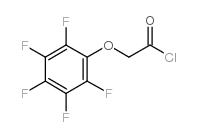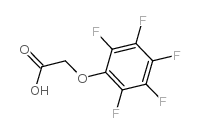55502-53-9
| 中文名 | 2,3,4,5,6-五氟苯氧基乙酰基氯 |
|---|---|
| 英文名 | 2,3,4,5,6-pentafluorophenoxyacetyl chloride |
| 中文别名 | 2,3,4,5,6-五氟苯氧基乙酰氯 |
| 英文别名 |
2-(2,3,4,5,6-pentafluorophenoxy)acetyl chloride
MFCD01320685 EINECS 259-676-2 |
| 密度 | 1.633g/cm3 |
|---|---|
| 沸点 | 116-117°C 20mm |
| 分子式 | C8H2ClF5O2 |
| 分子量 | 260.54500 |
| 闪点 | 116-117°C/20mm |
| 精确质量 | 259.96600 |
| PSA | 26.30000 |
| LogP | 2.52630 |
| 折射率 | 1.451-1.453 |
| 储存条件 | 保持贮藏器密封、储存在阴凉、干燥的地方,确保工作间有良好的通风或排气装置 |
| 稳定性 | 如果遵照规格使用和储存则不会分解,未有已知危险反应 |
| 计算化学 | 1.疏水参数计算参考值(XlogP):3 2.氢键供体数量:0 3.氢键受体数量:7 4.可旋转化学键数量:3 5.互变异构体数量:无 6.拓扑分子极性表面积26.3 7.重原子数量:16 8.表面电荷:0 9.复杂度:251 10.同位素原子数量:0 11.确定原子立构中心数量:0 12.不确定原子立构中心数量:0 13.确定化学键立构中心数量:0 14.不确定化学键立构中心数量:0 15.共价键单元数量:1 |
| 更多 | 1. 性状:液体 2. 密度(g/mL,25ºC):未确定 3. 相对蒸汽密度(g/mL,空气=1): 未确定 4. 熔点(ºC):未确定 5. 沸点(ºC):未确定 6. 沸点(ºC,20mm hg):116-117 7. 折射率:1.451-1.453 8. 闪点(°F):116-117°C/20mm 9. 比旋光度(ºC):未确定 10. 自燃点或引燃温度(ºC): 未确定 11. 蒸气压(kPa,25ºC):未确定 12. 饱和蒸气压(kPa,60ºC):未确定 13. 燃烧热(KJ/mol):未确定 14. 临界温度(ºC):未确定 15. 临界压力(KPa):未确定 16. 油水(辛醇/水)分配系数的对数值:未确定 17. 爆炸上限(%,V/V):未确定 18. 爆炸下限(%,V/V):未确定 19. 溶解性:未确定 |
Synonym:None Known Section 2 - COMPOSITION, INFORMATION ON INGREDIENTS
Risk Phrases: 14 34 Section 3 - HAZARDS IDENTIFICATION EMERGENCY OVERVIEW
Reacts violently with water. Causes burns.Moisture sensitive.Corrosive.Lachrymator (substance which increases the flow of tears). Potential Health Effects Eye: Causes eye burns. Produces irritation, characterized by a burning sensation, redness, tearing, inflammation, and possible corneal injury. Lachrymator (substance which increases the flow of tears). May cause chemical conjunctivitis and corneal damage. Skin: Causes skin burns. May cause skin rash (in milder cases), and cold and clammy skin with cyanosis or pale color. Ingestion: May cause severe and permanent damage to the digestive tract. Causes gastrointestinal tract burns. May cause perforation of the digestive tract. May cause cardiac disturbances. The toxicological properties of this substance have not been fully investigated. May cause central nervous system effects. May cause systemic effects. Inhalation: Causes chemical burns to the respiratory tract. The toxicological properties of this substance have not been fully investigated. Aspiration may lead to pulmonary edema. May cause cardiac abnormalities. May cause systemic effects. May cause Central Nervous System Effects characterized by apathy, mental confusion, blurred vision, and tremors. Chronic: Effects may be delayed. Section 4 - FIRST AID MEASURES Eyes: Get medical aid immediately. Do NOT allow victim to rub eyes or keep eyes closed. Extensive irrigation with water is required (at least 30 minutes). Skin: Get medical aid immediately. Immediately flush skin with plenty of water for at least 15 minutes while removing contaminated clothing and shoes. Wash clothing before reuse. Destroy contaminated shoes. Ingestion: Do not induce vomiting. If victim is conscious and alert, give 2-4 cupfuls of milk or water. Never give anything by mouth to an unconscious person. Get medical aid immediately. Inhalation: Get medical aid immediately. Remove from exposure and move to fresh air immediately. If breathing is difficult, give oxygen. Do NOT use mouth-to-mouth resuscitation. If breathing has ceased apply artificial respiration using oxygen and a suitable mechanical device such as a bag and a mask. Notes to Physician: Section 5 - FIRE FIGHTING MEASURES General Information: As in any fire, wear a self-contained breathing apparatus in pressure-demand, MSHA/NIOSH (approved or equivalent), and full protective gear. During a fire, irritating and highly toxic gases may be generated by thermal decomposition or combustion. Water Reactive. Material will react with water and may release a flammable and/or toxic gas. Containers may explode in the heat of a fire. Vapors may be heavier than air. They can spread along the ground and collect in low or confined areas. Contact with metals may evolve flammable hydrogen gas. Runoff from fire control or dilution water may cause pollution. Extinguishing Media: Do NOT get water inside containers. For small fires, use dry chemical, carbon dioxide, or water spray. For large fires, use dry chemical, carbon dioxide, alcohol-resistant foam, or water spray. Cool containers with flooding quantities of water until well after fire is out. Section 6 - ACCIDENTAL RELEASE MEASURES General Information: Use proper personal protective equipment as indicated in Section 8. Spills/Leaks: Absorb spill with inert material (e.g. vermiculite, sand or earth), then place in suitable container. Avoid runoff into storm sewers and ditches which lead to waterways. Clean up spills immediately, observing precautions in the Protective Equipment section. Provide ventilation. Do not get water inside containers. Section 7 - HANDLING and STORAGE Handling: Use only in a well-ventilated area. Do not breathe dust, vapor, mist, or gas. Do not get in eyes, on skin, or on clothing. Keep container tightly closed. Do not ingest or inhale. Do not allow contact with water. Discard contaminated shoes. Keep from contact with moist air and steam. Storage: Store in a cool, dry place. Keep container closed when not in use. Store in a tightly closed container. Corrosives area. Store protected from moisture. Section 8 - EXPOSURE CONTROLS, PERSONAL PROTECTION Engineering Controls: Facilities storing or utilizing this material should be equipped with an eyewash facility and a safety shower. Use adequate ventilation to keep airborne concentrations low. Exposure Limits CAS# 55502-53-9: Personal Protective Equipment Eyes: Wear appropriate protective eyeglasses or chemical safety goggles as described by OSHA's eye and face protection regulations in 29 CFR 1910.133 or European Standard EN166. Skin: Wear appropriate protective gloves to prevent skin exposure. Clothing: Wear appropriate protective clothing to prevent skin exposure. Respirators: Follow the OSHA respirator regulations found in 29 CFR 1910.134 or European Standard EN 149. Use a NIOSH/MSHA or European Standard EN 149 approved respirator if exposure limits are exceeded or if irritation or other symptoms are experienced. Section 9 - PHYSICAL AND CHEMICAL PROPERTIES Physical State: Clear liquid Color: light yellow Odor: Not available. pH: Not available. Vapor Pressure: Not available. Viscosity: Not available. Boiling Point: Not available. Freezing/Melting Point: Not available. Autoignition Temperature: Not available. Flash Point: Not available. Explosion Limits, lower: Not available. Explosion Limits, upper: Not available. Decomposition Temperature: Solubility in water: Specific Gravity/Density: Molecular Formula: C8H2ClF5O2 Molecular Weight: 260.4578 Section 10 - STABILITY AND REACTIVITY Chemical Stability: Stable at room temperature in closed containers under normal storage and handling conditions. Moisture sensitive. Conditions to Avoid: Incompatible materials, moisture, excess heat. Incompatibilities with Other Materials: Moisture, oxidizing agents. Hazardous Decomposition Products: Hydrogen chloride, carbon monoxide, irritating and toxic fumes and gases, carbon dioxide, hydrogen fluoride gas. Hazardous Polymerization: Has not been reported Section 11 - TOXICOLOGICAL INFORMATION RTECS#: CAS# 55502-53-9 unlisted. LD50/LC50: Not available. Carcinogenicity: Pentafluorophenoxyacetyl Chloride - Not listed by ACGIH, IARC, or NTP. Section 12 - ECOLOGICAL INFORMATION Ecotoxicity: Fish: Pseudomonas putida: Section 13 - DISPOSAL CONSIDERATIONS Dispose of in a manner consistent with federal, state, and local regulations. Section 14 - TRANSPORT INFORMATION IATA Shipping Name: CORROSIVE LIQUID, ACIDIC, ORGANIC, N.O.S. Hazard Class: 8 UN Number: 3265 Packing Group: II IMO Shipping Name: CORROSIVE LIQUID, ACIDIC, ORGANIC, N.O.S. Hazard Class: 8 UN Number: 3265 Packing Group: II RID/ADR Shipping Name: CORROSIVE LIQUID, ACIDIC, ORGANIC, N.O.S. Hazard Class: 8 UN Number: 3265 Packing group: II Section 15 - REGULATORY INFORMATION European/International Regulations European Labeling in Accordance with EC Directives Hazard Symbols: C Risk Phrases: R 14 Reacts violently with water. R 34 Causes burns. Safety Phrases: S 3/7 Keep container tightly closed in a cool, well-ventilated place. S 26 In case of contact with eyes, rinse immediately with plenty of water and seek medical advice. S 27 Take off immediately all contaminated clothing. S 36/37/39 Wear suitable protective clothing, gloves and eye/face protection. WGK (Water Danger/Protection) CAS# 55502-53-9: No information available. Canada None of the chemicals in this product are listed on the DSL/NDSL list. CAS# 55502-53-9 is not listed on Canada's Ingredient Disclosure List. US FEDERAL TSCA CAS# 55502-53-9 is not listed on the TSCA inventory. It is for research and development use only. SECTION 16 - ADDITIONAL INFORMATION N/A |
|
生态学数据: 对水是稍微有危害的不要让未稀释或大量的产品接触地下水、水道或者污水系统,若无政府许可,勿将材料排入周围环境。
|
| 危害码 (欧洲) | C |
|---|---|
| 风险声明 (欧洲) | 34-14 |
| 安全声明 (欧洲) | S36/37/39-S3/7-S27-S26 |
| 危险品运输编码 | 3265 |
| 包装等级 | III |
| 危险类别 | 8 |
| 海关编码 | 2918990090 |
|
~94% 
55502-53-9 |
| 文献:US6369049 B1, ; Example 1 ; |
| 上游产品 1 | |
|---|---|
| 下游产品 0 | |
| 海关编码 | 2918990090 |
|---|---|
| 中文概述 | 2918990090. 其他含其他附加含氧基羧酸(包括酸酐、酰卤化物、过氧化物和过氧酸及该税号的衍生物). 增值税率:17.0%. 退税率:13.0%. 监管条件:无. 最惠国关税:6.5%. 普通关税:30.0% |
| 申报要素 | 品名, 成分含量, 用途 |
| Summary | 2918990090. other carboxylic acids with additional oxygen function and their anhydrides, halides, peroxides and peroxyacids; their halogenated, sulphonated, nitrated or nitrosated derivatives. VAT:17.0%. Tax rebate rate:13.0%. . MFN tariff:6.5%. General tariff:30.0% |


